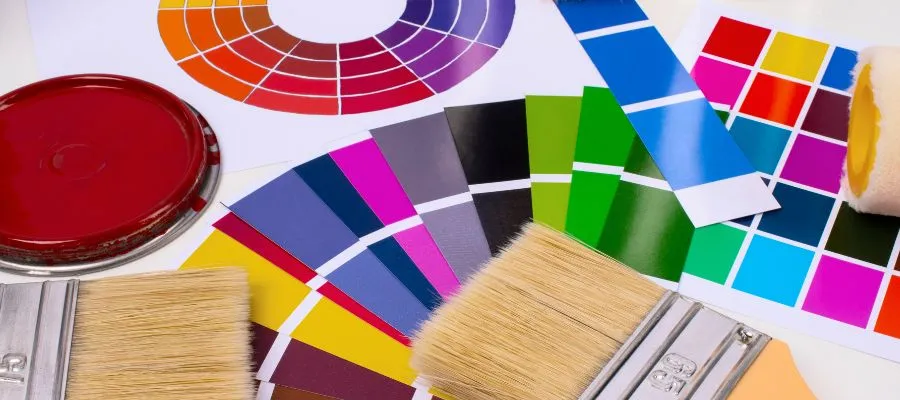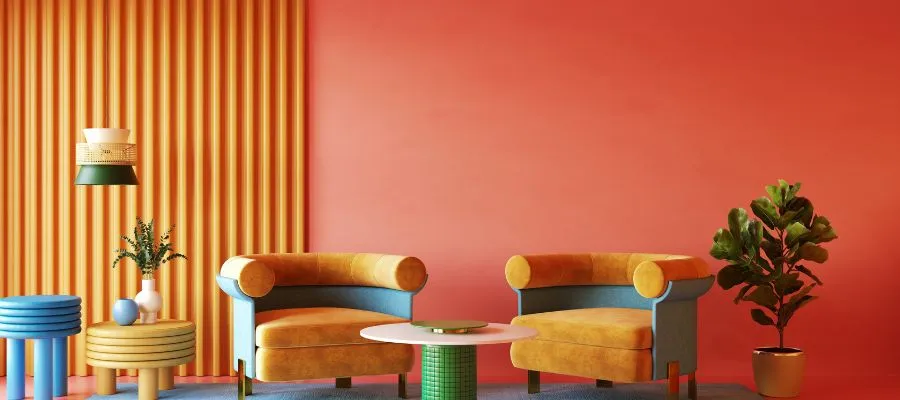Choosing the right paint colours for the interior rooms of your home can be both fun and hard. A room’s mood, atmosphere, and general feel can greatly affect the colours you choose. This detailed blog guide, Brick & Bolt, will show you how to choose the best paint colours for your style and tastes, whether you want a cosy, peaceful bedroom or a lively, inviting living room.
How to Understand the Psychology of House Painting Colours

It’s important to know the basics of colour psychology before getting into the details of picking paint colours. Colours can change your mood and behaviour by making you feel different feelings. Warm colours, like red, orange, and yellow, tend to make people feel cosy, warm, and energised. Cool colours, like blue, green, and purple, are known to calm and soothe. Neutral colours, like beige, grey, and white, are flexible and can be used as a background for other colours that are used as accents.
How to Choose the Interior Paint Colours
It can be hard to decide what colours to paint for your home, but with a little help, you can make choices you’ll be happy with. Here are the steps you need to take to pick the right paint colours:
1. Think About the Mood:
Think about how you want each room to feel. Would you like it to feel warm and cosy or open and airy? The colour you pick can greatly affect how the room feels.
2. Get Ideas:
You can find ideas in books, on the Internet, or even in nature. When you see rooms or colour choices that you like, save them. This will help you figure out what colour scheme you like best.
3. Check the Lighting:
Write down how much natural light comes into each room at different times of the day. Darker colours can work in rooms with lots of natural light, but rooms with less light might feel too closed in and need lighter colours.
4. Think About the Room’s Purpose:
The room’s purpose can also affect your chosen colour. For instance, you might want soft colours in the bedroom and bright ones in the creative workshop or playroom.
5. Pick a Base Colour:
Pick a neutral base colour for the walls. Neutral colours like white, beige, grey, or greige (a mix of grey and beige) make a great background for a wide range of furniture and home decor styles.
6. Check Out Accent Colours:
Once you have your base colour, you might want to add accent colours to make things look more interesting. You can use these on trim, accent walls, or home decor items like pillows, curtains, and art.
7. Think About the Flow:
Picture how the colours in one room will flow into the next. You want your home to have a smooth flow, so think about how the colour schemes of each room connect to those of the others.
8. Test Samples:
Before you decide on a colour, buy small samples and put paint swatches on the walls to see how they look in different lights. This will help you picture how the colour will look when spread out over a bigger area.
9. Take into Account Existing Furniture:
Think about any furniture or decorations you already have that you want to keep in the room. When you paint, make sure the colours you pick don’t clash with these things.
10. Trust Your Instincts:
Choose colours that make you feel good. If you want your home to show off your personality and style, go with your gut regarding colour. By following these steps and taking your time to look at different choices, you can choose paint colours that make the inside of your home look and feel better.
Common Mistakes to Avoid While Selecting the Paint Colour For Interior Rooms

Picking paint for your home can be a big choice that affects how it looks and works. Here are five mistakes that people often make when picking paint:
1. Paint can have very different looks in different lights. People often make the mistake of picking a colour based only on how it looks in the store or on the internet. You should always put paint samples on your walls and look at them at different times to ensure you like the colour in all kinds of light.
2. Every paint colour has neutral, warm, or cool undertones. If you don’t pay attention to the undertones, colours may clash with your current decor or set an unintended mood in the room. Think about the hues of the paint you choose and how they might work with or against other things in the room.
3. You need a primer to get a smooth paint finish that lasts a long time. It gives the paint a stable base to stick to, makes the coverage better, and can help hide flaws. If you don’t use primer, the paint might not stick well, cover evenly, or need more coats.
4. Paint has different finishes, like white, satin, semi-gloss, and gloss. Different finishes have different qualities, such as how long they last, how shiny they are, and how easy they are to clean. Think about what you want to do with the room you’re painting and pick a finish that works for you. For instance, hallways and kitchens that get a lot of use might benefit from a more durable finish and easy to clean. On the other hand, a matte finish can make beds and living rooms feel more cozy.
5. Preparing the area correctly is very important for getting a paint job that looks professional. This includes smoothing rough surfaces, filling in holes or cracks, and cleaning the walls to remove dirt, dust, and grease. Painter’s tape should also be used to protect the trim and surfaces next to it. If you don’t prepare correctly, the paint might not stick well, cover evenly, or give you a good result.
Choosing the paint colours for the interior rooms of your home is unique and creative. You can be sure you’ll choose the right colours for each room by learning about colour psychology, evaluating your space, trying different colour schemes, touching up paint samples, and thinking about finishes. If you plan and do it right, you’ll be able to make a home that fits your style and tastes.
If you want to explore more about different types of paints for your home. Click the link below.

